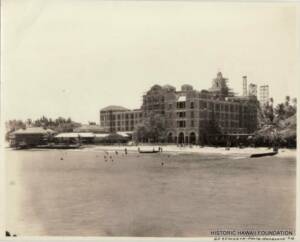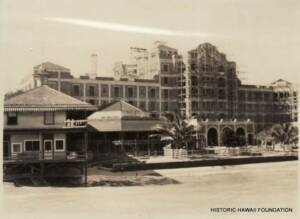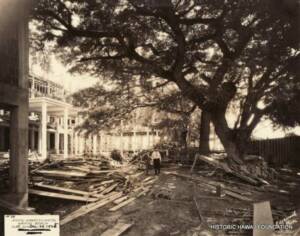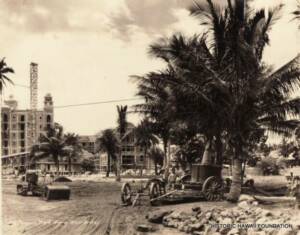In 1924, the Seaside Hotel’s lease of the land at Helumoa was soon to expire and the land’s owners put out a request for proposals to build a hotel, with a minimum construction cost of $100,000, that would better capitalize on the ideal setting.
The offer: a 50-year lease of 3.75 acres of beach front land on Waikiki Beach. Incorporating additional surrounding land was also an option extended to potential developers.
In post World War I Hawaii, Matson Navigation Co. had big plans to build luxury ocean liners to bring wealthy tourists to Hawaii. But, they needed a hotel equally lavish at Waikiki. Soon Matson’s luxury ocean liner and its 650 wealthy passengers would be arriving in Honolulu every two weeks and the two largest hotels, the Alexander Hotel and the Moana, could not accommodate all of them. The availability of the Bishop Estate land began putting wheels into motion.
In March 1925, William Roth, Manager of Matson Navigation Company, and his wife Lurline (who’s maiden name was Matson), and Mrs. William Matson, the widow of the founder of Matson Navigation Company, arrived in Honolulu for a three-week stay so that Roth could attend the annual Matson conference. Famous New York-based architect Charles V. Wetmore also arrived in Honolulu at the invitation of Matson Navigation Company leadership.
Wetmore advised Matson Navigation that “Honolulu is one of the wonder spots of the world, and it should have a hotel that is as much of an attraction as the city itself.”
Castle & Cooke, Matson Navigation and the Territorial Hotel Company successfully proposed a plan to to build a luxury hotel, with 400 rooms, at a cost of $2 million on the 15-acre parcel of Waikiki beach to be leased from the Bishop Estate.
Warren & Wetmore, who were known for their other hotels, including NYC’s Ritz-Carlton, Biltmore, Belmont, Vanderbilt and Chatham hotels, were selected as the architects.
The ground-breaking ceremony took place on July 26, 1925, before a building permit was issued or a contract was signed with the building contractor, Ralph Wooley. By the time the contract was executed on September 5, 1925, some three hundred men were already at work.
The building permit still was not signed by August, and the City withheld granting it unless the building codes were first revised. The planning commission did not want to revise the building code to allow high rises on Waikiki beach. The City and County Board of Supervisors disregarded their concerns and allowed the increase in heights. This would forever change the landscape of Waikiki, as the decision also allowed much taller highrises to be built in the area.





